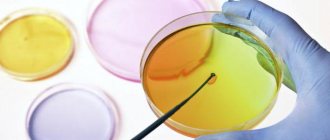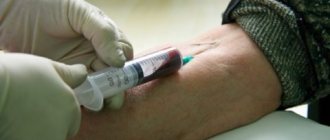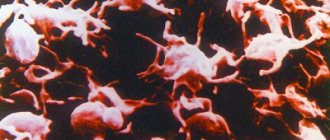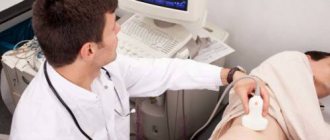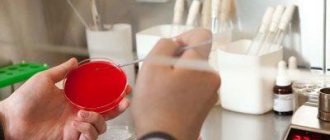Ureaplasma is an opportunistic microorganism that causes genitourinary infections in women and men. The disease caused by this microorganism is called ureaplasmosis and can occur with a variety of clinical symptoms or without any manifestations. That is why timely diagnosis and treatment of ureaplasmosis is necessary. Modern diagnostic measures allow you to quickly and accurately determine the presence of a microbe in the body, making it possible to get rid of the disease in a short time. The main diagnostic method is culture for ureaplasma with determination of sensitivity to antibiotics. This highly informative analysis not only makes it possible to find out about the presence of infection in the body, but also at the same time to select the optimal treatment.
Sowing: the essence of the cultural method
A tank inoculated for ureaplasma allows you to grow a culture of live bacteria. This study is the most specific. At the same time, it is inferior to PCR in sensitivity.
The essence of the method is that clinical material is taken from the patient (for example, scraping of cells of the urogenital tract). It is placed on a nutrient medium. It is favorable for the growth of ureaplasmas. Therefore, bacteria begin to actively multiply. They form colonies.
After a few days, when colonies appear, measures are taken to identify the bacteria. Ureaplasma grows in difficult environments. They contain proteins, peptones, horse serum, and yeast extract. Amino acids are often included in the composition.
Such environments are also suitable for the development of other bacteria. Their growth negatively affects ureaplasma colonies. In addition, it may make it difficult to identify bacteria or make accurate quantification impossible. Therefore, antibiotics are added to the media, to which ureaplasma is insensitive.
This is usually benzylpenicillin.
Amphotericin B is used to suppress fungal flora.
Disadvantages of sowing and cultivating mycoplasmas:
- long term – from 4 days
- high requirements for nutrient media
- sometimes autolysis of colonies occurs
- labor intensity
- low degree of standardization
Identification of bacteria is carried out by morphological properties, as well as biochemical ones. Ureaplasma differs in that it can metabolize urea.
Mycoplasmas look exactly the same on nutrient media. But they differ in biochemical properties. Namely, they do not break down urea, but they hydrolyze arginine.
Bacteriological smear
A smear for ureaplasmosis is taken in the presence of an inflammatory process on the mucous membrane of the vagina or urethra. How is a smear taken? To do this, the gynecologist first inserts a speculum into the vagina. The manipulation itself is not painful, but causes the woman minor discomfort. During the procedure, the patient’s breathing should be calm and deep, and the vaginal muscles should not be strained. This will help reduce discomfort.
Where do they get the material for analysis? Using a sterile probe, a smear is made from 3 places: from the mucous membrane of the cervical canal of the cervix, vagina and urethra. The doctor applies the material taken in this way onto a glass slide. The smear is stained with a special paint and examined under a microscope. Each type of bacteria gets its own shade.
A bacteriological smear from a healthy patient reveals not only beneficial microorganisms, such as lactobacilli, but also a small amount of streptococci, staphylococci, and fungi. Such indicators are considered to be the norm. The presence of an infectious disease is indicated by a change in the composition of the vaginal microflora and the presence of inflammatory processes in the genital area.
Why do they culture for ureaplasma?
The objectives of the study are the following:
- Establishing the fact of the presence of ureaplasma in the urogenital tract
- Determination of the quantity, which allows us to assess the role of ureaplasmas in the inflammatory process and predict the further development of the disease
- Determine sensitivity to antibiotics and find out which ones are best suited to treat this infection
Cultures are rarely done for the initial diagnosis of infection. Because it takes a lot of time. PCR is often used for this purpose.
Tank culture is usually done if there is a need to determine the sensitivity of the flora to antibiotics. In turn, such a need arises if the first course of therapy for ureaplasmosis failed. After treatment, cure is monitored. It can also be carried out using a tank inoculating for ureaplasma.
If bacteria are detected again and their numbers are not significantly reduced, this means that treatment has failed. The reason for this is most often the human factor.
Many patients do not take medications on time or change dosages. The second reason is bacterial resistance to antibiotics. With the help of a tank culture for ureaplasma, this problem is solved.
Because after isolating cultures, it is possible to determine which drugs most strongly inhibit the activity of bacteria. In the future, they are prescribed for the treatment of the disease.
Norm and interpretation of analysis results
When analyzing for ureaplasma urealyticum, parvum (spp), the norm is considered to be a quantitative value of microorganisms of up to 104 CFU per 1 ml of the test material. The presence of bacteria in such a volume is considered a normal result and means that there is no inflammation, but the person is a carrier of ureaplasma urealyticum or parvum infection. If, when deciphering the results of the study, the doctor discovers that the value of microorganisms urealiticum or parvum exceeds the norm, then this indicates the progression of the inflammatory process and requires a course of treatment.
The effectiveness of treatment is increased by testing for sensitivity to certain antibiotics, which is designated by the abbreviation ACh. For this purpose, a special set of AC reagents in various configurations is used. During the study, AN determines the sensitivity of the bacteria ureaplasma urealyticum to 12 or more antibiotics. After receiving the test results, the doctor has a complete picture of the condition of the microorganisms and what treatment will be effective.
Often doctors prescribe a repeat test, since it is possible that the results were incorrect. This can happen due to human factor (laboratory technician error), or lack of preparation on the part of the patient. Also, re-testing is required in the following cases:
- with incorrect and ineffective treatment;
- with progression of inflammatory processes;
- for monitoring purposes after a course of therapy;
- with the development of a concomitant sexually transmitted infection.
If, according to the results of the study, the quantitative value of microorganisms is within the normal range, then treatment is prescribed according to the patient’s personal request. If surgical treatment or pregnancy is planned, then therapy is mandatory; this will require a mandatory antibiotic sensitivity test (AS). There are also additional methods for studying ureaplasmosis and these include: ELISA (enzyme-linked immunosorbent assay) - allows you to detect antibodies in the blood for ureaplasma; PCR (polysize chain reaction); RNIF and RPIF (indirect and direct immunofluorescence).
Where does ureaplasma come from in women?
Women are often surprised to learn that they have ureaplasma in their bodies.
Where does it come from?
This bacterium is transmitted sexually. Moreover, if it is discovered, it is not a fact that it happened recently.
It is likely that ureaplasma has already been parasitizing in the patient’s body for several years. Because ureaplasma carriage lasts a very long time.
Often these bacteria cause no symptoms at all.
They can only appear:
- with decreased immunity
- against the background of other inflammatory processes
- with the addition of other STDs
- in case of disturbance of the vaginal biocenosis, etc.
With an increase in the ureaplasma population, inflammatory processes appear. This can happen in the first weeks after infection.
In other cases - only after a few years, under the influence of predisposing factors. Then the woman goes to the doctor, is examined, and this microorganism is found in the urogenital tract.
Symptoms
The symptoms of ureaplasmosis are similar to urogenital inflammation, and the disease can be differentiated only after testing.
Among women
The presence of a genital tract infection in a woman is determined based on her own feelings. The quantity and quality of vaginal discharge changes, urination is accompanied by pain. Painful sensations in the lower abdomen are also periodically observed, which intensify during coitus or menstruation.
Characteristic symptoms:
- an abundance of discharge, at first odorless, absolutely transparent, then having a sweet aroma, yellowish;
- During menstruation, cramps in the lower abdomen are noted;
- urination becomes more frequent and painful, followed by a burning sensation in the urethra - usually women mistake this symptom for an exacerbation of cystitis and begin treatment. When antibiotics are stopped, the disease worsens again or may become chronic. The result of such self-medication can be infertility.
A decrease in libido can also be considered as a symptom of an inflammatory process in a woman. Feeling pain in the vagina after sexual intercourse, women refuse sex, which negatively affects their psychological state.
Sometimes ureaplasmosis is accompanied only by painful sensations after sexual intercourse, and women do not consult a doctor because they believe that it is caused solely by psychological reasons.
Symptoms of ureaplasmosis often appear during pregnancy (in the first trimester). This condition reduces immunity, disrupts the balance of pathogenic and conditionally pathogenic microorganisms in the vagina.
In men
In men, signs of ureaplasma resemble the manifestation of sexually transmitted diseases and inflammatory pathologies of the genital tract caused by hypothermia.
Ureaplasmosis is manifested by the following symptoms:
- discomfort, pain and burning when urinating;
- scanty glassy discharge in the morning and during urination;
- itching and burning of the edge of the urethra and penis;
- increased frequency of urination – dysuric syndrome;
- accelerated ejaculation.
In the absence of adequate treatment, ureaplasma spreads upward, affecting the bladder, testicles, testes and prostate. A possible result of infection may be infertility.
The introduction of infection in men causes dangerous complications: narrowing of the urethra and urethritis, inflammation of the epididymis - epididymitis, prostatitis. With prostatitis, erectile function is impaired.
With increased activity, ureaplasma can spread through the bloodstream to absolutely all organic systems and organs, which provokes inflammatory processes:
- From the musculoskeletal system - arthritis.
- From the excretory system - bladder and kidneys: cystitis, glomerulonephritis and pyelonephritis, urolithiasis.
- From the respiratory system, the development of pneumonia is possible.
The most severe complication if the infection spreads through the bloodstream and enters the brain is meningitis. This is a deadly disease that can be fatal if left untreated.
Types of ureaplasma in women
The female body is parasitized by 2 types of ureaplasma. These bacteria are detected in 19% of people with one partner. Among people who had 3 or more partners during the year, the prevalence of this infection reaches 45%.
Ureaplasma parvum has a higher prevalence. The outdated name is ureaplasma T 960. It was used until 2000. Then it was believed that this was one of the varieties of ureaplasma urealiticum.
But today they are divided into two types. Because they differ in their pathogenicity. Although Ureaplasma parvum is more common, it is less pathogenic.
Usually this is a saprophytic flora that does not cause any inflammatory reactions. Ureaplasma urealiticum is more dangerous in women.
Most cases of ureaplasma urethritis or complications during pregnancy are associated with it.
Norm
The presence of ureaplasma is normal for the natural male microflora. These are bacteria that live on the mucous membrane of the urinary tract and genital organs of men. Normally, such microorganisms are not active.
Analysis in men for ureaplasma urealyticum is carried out much less frequently than for ureaplasma parvum.
As a rule, transmission occurs in two ways: through contact with an infected woman or from the mother, if she has such microorganisms.
Ureaplasmosis in general is observed in men less often than in the fairer sex.
How to take material for culture for mycoplasma and ureaplasma
For culture, smears from the urethra are mainly used.
In women, they are also taken from the vagina. It is possible to collect clinical material from the cervical canal.
Ureaplasma may not be detected in the discharge. Because it is tightly attached to the surface of epithelial cells.
To identify it you need to scrape the cells. The material is taken with a special brush.
She scrapes off the top layer of the mucous membrane.
The first portion of urine can also be used for culture.
Indications for testing
Bakposev is carried out in the presence of complaints in the direction of a doctor - gynecologist or urologist. When he is discharged, the microbiological examination form always indicates the drugs commonly used for treatment, usually in quantities of 7-10.
Inflammatory reactions from the genitourinary system cause a blurred clinical picture, difficult to diagnose without the help of laboratory services:
- dysuric phenomena: painful urination, pain, frequent visits to the toilet, small volume of urine;
- discomfort and pain during sexual intercourse;
- pain in the groin and suprapubic region, rarely in the inner thigh;
- enlargement of local lymph nodes, pain when touched, redness and swelling of the skin in this area;
- Women often experience menstrual irregularities, abnormal uterine bleeding, and pain in the lumbar region;
- discharge from the urethra or vagina with a strong or unpleasant odor;
- general symptoms: weakness, decreased performance, apathy, fever.
Unfortunately, in approximately 55-60% of cases there are no symptoms. A person is a carrier of infection without knowing it.
Ureaplasma in a smear in women 10 to 4 degrees
The sowing tank is good because it determines quantitative indicators. True, their practical application is limited.
Studies show that inflammatory processes in the urethra are 3 times more likely to occur when the concentration of ureaplasma is 10 to 4 degrees CFU or more. But with a smaller amount, inflammation is also possible.
The symptoms are simply less pronounced and occur with less frequency. Thus, the determination of quantity is more of a scientific interest than a practical one. Because most doctors, when deciding whether to prescribe or cancel treatment, are not guided by the number of ureaplasmas.
Other, more significant factors are taken into account. The number of ureaplasmas is an unstable indicator. It constantly increases and decreases.
There is an increase in the number of ureaplasmas when sowing in the second half of the menstrual cycle, as well as against the background of:
- hypothermia
- drinking alcohol
- decreased immunity
Many factors can improve quantitative indicators for a while. During this same period, the likelihood of inflammatory processes increases.
Causes
When microorganisms are in a latent form in the human body, the pathogenic process can be started if the general microflora of the male body is disrupted, including the microflora of the mucous membrane of the genital organs and urinary tract. Such a violation can be caused by:
- violations of rest and nutrition, which reduces the quality of life, the man’s body becomes more susceptible to infections;
- antibiotics and hormonal drugs can also become a source of illness.
Since the spread of microorganisms occurs throughout the mucous membrane of the genitourinary system, pathology can begin in any part of it. At first it is an inflammatory process, but at the same time it is a harbinger of more serious diseases: urethritis; urolithiasis; arthritis; epididymitis; prostatitis. If the case is more serious, it can deteriorate the quality of sperm and cause complete infertility in a man.
So, let’s figure out how to test for ureaplasma in men.
When is treatment for ureaplasma necessary?
Previously, it was believed that quantitative indicators could be used to determine indications for treatment. Today there are fewer and fewer supporters of this approach.
This is due to the fact that:
- ureaplasma concentration is unstable
- inflammatory processes can occur even with a small amount of them
- Ureaplasma carriage is fraught with the spread of infection
- the amount of ureaplasma can increase significantly after pregnancy, and this can result in spontaneous abortion
- with prolonged carriage of ureaplasmas, Reiter's disease can develop - reactive inflammation of the joints, tendons, and skin
Therefore, treatment is carried out, regardless of the number of identified ureaplasmas, if:
- there are symptoms of inflammation of the urogenital tract
- a woman is planning a pregnancy in the near or at least distant future
- the patient is sexually active and changes sexual partners from time to time (naturally, he infects them)
Ureaplasma increases the risk of developing inflammatory diseases of the pelvic organs. They increase susceptibility to other sexually transmitted infections.
Ureaplasma causes complications during pregnancy.
They can infect a child in utero or at birth. Therefore, if they are detected in crops, it is worth undergoing a course of treatment to get rid of ureaplasma.
Definition of research
A smear is a collection of cells from the mucous membrane of a certain organ for the purpose of diagnosing infectious diseases.
To study the collected material, various laboratory diagnostic methods are used, which make it possible to identify the causative agent of the infection:
- microscopy of bacteriological smear;
- PCR method;
- cultural sowing.
How long does it take to test for ureaplasmosis? The period required to obtain results depends on the research methodology. The fastest way is smear microscopy. However, its results are preliminary and are not used to make a final diagnosis. The choice of method for determining ureaplasma in a smear is made by a doctor depending on the clinical situation.
Antibiotic sensitivity culture
Ureaplasmas sometimes turn out to be insensitive to treatment. Then a culture for antibiotics is required.
During the study, the doctor can find out which drugs ureaplasma is sensitive to. Tetracyclines are most often used for treatment. These antibiotics inhibit protein synthesis.
Resistance to them in ureaplasmas is rarely observed - in 10% of cases. The risk increases significantly if the patient tried to treat himself.
Self-medication is an indication for antibiotic culture. Research demonstrates the effectiveness of this approach.
On average, after a course of therapy, control studies show that ureaplasma is re-isolated in 37% of patients. But if ureaplasma was cultured for antibiotics before starting treatment, then the risk of treatment failure is reduced to 8%.
Comparison of culture with other tests
Tank culture differs from other tests in its high specificity. It does not give false negative results.
The method detects only living bacteria. Because dead microorganisms cannot grow on the culture medium. This is different from PCR.
Molecular methods detect DNA fragments even if the bacteria themselves have already been destroyed by antibiotics.
At the same time, culture for ureaplasma is inferior to PCR in sensitivity. It gives false negative results more often. Both methods allow obtaining quantitative indicators.
An additional advantage of culture is the ability to assess sensitivity to antibiotics, which increases the subsequent effectiveness of therapy.
Culture for ureaplasma: where to go
If you experience signs of inflammation of the urogenital tract, contact our clinic. We can test you for any infection. This includes culture for ureaplasma.
We use the services of proven laboratories. We follow all the rules for collecting and transporting biomaterial. Therefore, you will receive reliable research results in our clinic.
An experienced venereologist will interpret the test results. He will determine the indications for therapy.
If necessary, he will carry out treatment based on the sensitivity of the isolated ureaplasma culture to antibiotics.
If you need to take a culture test for ureaplasma, contact the author of this article - a urologist, venereologist in Moscow with many years of experience.
Recommendations for preparation
For undoubted reliability, before taking the test for ureaplasma, men should carry out several preparatory procedures:
You need to urinate 2-3 hours before the test, but not later. When urinating right before the test, the urine will cleanse the mucous membrane of the canal and reduce the amount of necessary biomaterial, that is, the results will be distorted.
